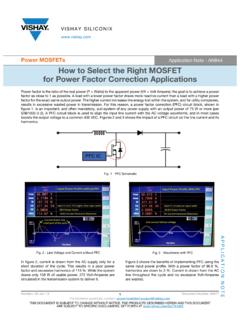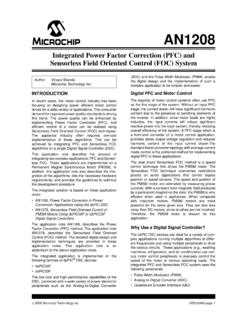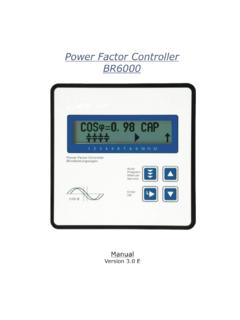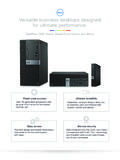Transcription of U-134 APPLICATION NOTE - TI.com
1 U-134 . APPLICATION NOTE. UC3854 Controlled power Factor correction Circuit Design PHILIP C. TODD. ABSTRACT. This APPLICATION Note describes the concepts and design of a boost preregulator for power factor correc- tion. This note covers the important specifications for power factor correction , the boost power circuit de- sign and the UC3854 integrated circuit which controls the converter. A complete design procedure is given which includes the tradeoffs necessary in the process. This design procedure is directly applicable to the UC3854A/B as well as the UC3854.
2 The recommendations in Unitrode Design Note DN-39 cover other ar- eas of the circuit and, while not discussed here, must be considered in any design. This APPLICATION note supersedes APPLICATION Note U- 125 " power Factor correction With the UC3854.. INTRODUCTION the input current waveform with respect to the input voltage waveform. The phase displacement of the The objective of active power factor correction is to voltage and current is the classic definition of make the input to a power supply look like a simple power factor which is the cosine of the phase angle resistor.
3 An active power factor corrector does this between the voltage and current sinusoids. by programming the input current in response to the input voltage. As long as the ratio between the PF=Cose voltage and current is a constant the input will be The amount of displacement between the voltage resistive and the power factor will be When the and current indicates the degree to which the load ratio deviates from a constant the input will contain is reactive. If the reactance is a small part of the phase displacement, harmonic distortion or both impedance the phase displacement will be small.
4 And either one will degrade the power factor. An active power factor corrector will generate The most general definition of power factor is the phase displacement of the input current if there is ratio of real power to apparent power . phase shift in the feedforward signals or in the con- trol loops. Any filtering of the AC line current will also produce phase displacement. Harmonic distortion is a measure of the non-linear- Where P is the real input power and Vrms and Irms ity of the input impedance of the active power fac- are the root mean square (RMS) voltage and cur- tor corrector.
5 Any variation of the input impedance rent of the load, or power factor corrector input in as a function of the input voltage will cause distor- this case. If the load is a pure resistance the real tion of the input current and this distortion is the power and the product of the RMS voltage and cur- other contributor to poor power factor. Distortion in- rent will be the same and the power factor will be creases the RMS value of the current without in- If the load is not a pure resistance the power creasing the total power being drawn. A non-linear factor will be below load will therefore have a poor power factor be- Phase displacement is a measure of the reactance cause the RMS value of the current is high but the of the input impedance of the active power factor total power delivered is small.
6 If the non-linearity is corrector. Any amount of reactance, either induc- small the harmonic distortion will be low. Distortion tive or capacitive will cause phase displacement of in an active power factor corrector comes from 3-269. APPLICATION NOTE U-134 . power Factor Versus Distortion power Factor Versus Distortion a high input power factor, usually much greater than But power factor is not a sensitive meas- ure of the distortion or the displacement of the cur- rent waveform. It is often more convenient to deal with these quantities directly rather than with the power factor.
7 For example, 3% harmonic distortion alone has a power factor of A current with 30% total harmonic distortion still has a power fac- tor of A current with a phase displacement of 25 degrees from the voltage has a power factor of The trend among the world standards organiza- tions responsible for power quality is to specify maximum limits for the amount of current allowed at each of the harmonics of the line frequency. IEC. 555-2 specifies each harmonic up through and be- yond the 15th and the amount of current permissi- ble at each. Table 1 lists the requirements for IEC.
8 555-2 as of the time of this writing. There are two parts to the specification, a relative distortion and an absolute distortion maximum. Both limits apply to all equipment. This table is included here as an example of a line distortion specification. It is not intended to be used for design purposes. The IEC. has not finalized the requirements of IEC 555 at this time and major changes are possible. Active power Factor correction A boost regulator is an excellent choice for the power stage of an active power factor corrector be- cause the input current is continuous and this pro- duces the lowest level of conducted noise and the best input current waveform.
9 The disadvantage of the boost regulator is the high output voltage re- Table 1 quired. The output voltage must be greater than the highest expected peak input voltage. several sources: the feedforward signals, the feed- The boost regulator input current must be forced or back loops, the output capacitor, the inductor and programmed to be proportional to the input voltage the input rectifiers. waveform for power factor correction . Feedback is An active power factor corrector can easily achieve necessary to control the input current and either 3-270. APPLICATION NOTE U-134 .
10 Figure 1. Basic Configuration of High power Factor Control Circuit peak current mode control or average current concept. An amplifier is used in the feedback loop mode control may be used. Both techniques may around the boost power stage so that input current be implemented with the UC3854. Peak current tracks the programming signal with very little error. mode control has a low gain, wide bandwidth cur- This is the advantage of average current mode rent loop which generally makes it unsuitable for a control and it is what makes active power factor high performance power factor corrector since correction possible.

















